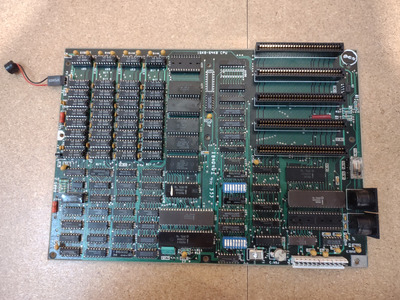Lylat1an wrote on 2022-09-23, 17:37:
Zyga64: Yes, I was thinking of the 2MB version of that card. I've heard of the Snark Barker, but not the BlasterBoard. I didn't know there were ISA ethernet cards either, thank you.
Maxtherabbit: What exactly would be the difference between Conventional and EMS memory? I thought EMS was just an expansion to conventional.
Those questions actually are about the same thing. The Lo-Tech 1MB board provides conventional memory, but the 2MB board provides expanded memory. The idea is that the 8088 processor can directly access 1024KB of "memory". This might either be "just normal working RAM" or special purpose memory like memory on graphics cards or the BIOS ROM chips. IBM decided to split the 1024KB memory range into 640KB for "normal RAM" and 384KB for "special purpose". The first 64KB of the special purpose area are neither used by the MDA or the CGA graphics adapter, so if you were to put standard RAM into that range, the "normal RAM" blends seemless into the first 64KB of the "special purpose" area. As these are just names for conventions, you get 704KB continous memory that can be directly accessed by the processor (but that configuration is incompatible with EGA or VGA cards).
As you see, directly accessible memory is maxed out at 640KB when keeping conventions, or up to 736KB in a configuration that is incompatible with EGA, VGA, MDA and Hercules cards, and allows CGA only. If you need more memory than you can directly access in the conventional way (thus the name "conventional memory"), you need to go to some convoluted way to access memory. The way EMS does it: It provides four windows of 16KB each somewhere in the "special purpose" area. Each of these windows can be used to access a software-selected block of the two megabytes on the card. If you want to scan through the whole memory, you need to continously switch out which blocks are visible in the windows.
Conventional memory is managed by DOS, and every DOS program can directly make use of conventional memory. EMS on the other hand is only used by software with big memory requirements. EMS is managed in cooperation between the EMS board driver and the application that decides which part of the EMS memory should be visible at what time. EMS thus is a special-purpose solution. Common users of EMS were database applications, disk caches, print spoolers or RAM drives. EMS is not "just memory".
The Lo-Tech 1MB board is able to map "simple memory" to any address imaginable in the 1024KB addressing range of the 8088. You are not going to use the whole 1MB, in fact, no one is, but you will use more than 512KB, and building a 1MB board with todays components is easier and cheaper than building something like a 800KB board which might be usable in full in certain circumstances. The 1MB board can be used to fill the gap between 64KB and 640KB, and optionally also some unused spaces in the special purpose area. You won't get far with 64KB of conventional memory (the on-board RAM), so you desparately need some board that provides conventional memory.
Lylat1an wrote on 2022-09-23, 17:37:Rmay635703: Are you saying "Backfill" as a bad thing, or do you mean it's taking the place of the onboard RAM?
Backfill is a term more often used with 16-bit Extended Memory boards (mind you: Extended Memory is an AT concept that is entirely different from Expanded Memory), and describes that some of the memory of a card that provides any kind of non-conventional memory (i.e. EMS or Extended Memory) is able to re-purpose some of that memory and provides it as conventional memory. Late EMS boards that are designed for the EMS 4.0 specification often have the capability to provide memory in the range intended for conventional memory.
Don't worry about people telling you that 8-bit memory boards are slow. They are indeed slow, but they are fast enough that the onboard RAM of the IBM PC/XT is equally slow. They only appear "slow" on faster machines that allow faster access to the on-board memory. You wouldn't want an 8-bit memory card of any kind in a 286 machine. An 8 MHz 286 machine can access fast 16-bit memory cards more than 3 times faster than the PC/XT can access its memory. On the other hand, access to 8-bit memory cards in AT-class machines might be even slower than in the PC, because 8-bit access is slowed down to be "not faster than on the PC" to be compatible to that old machine.
